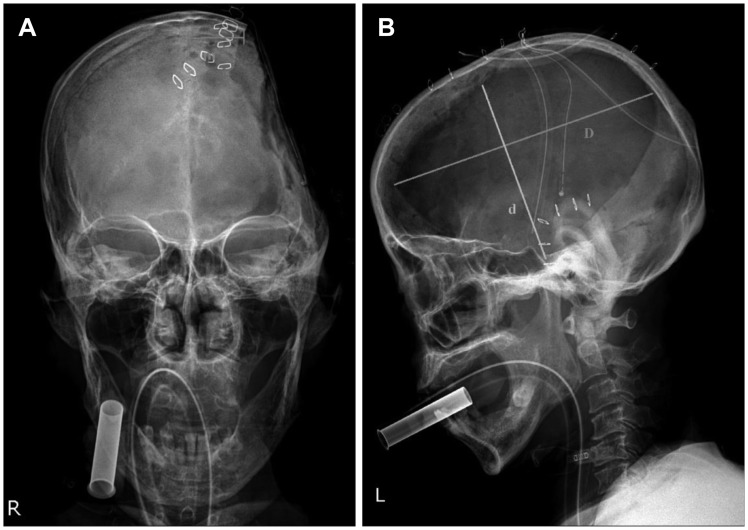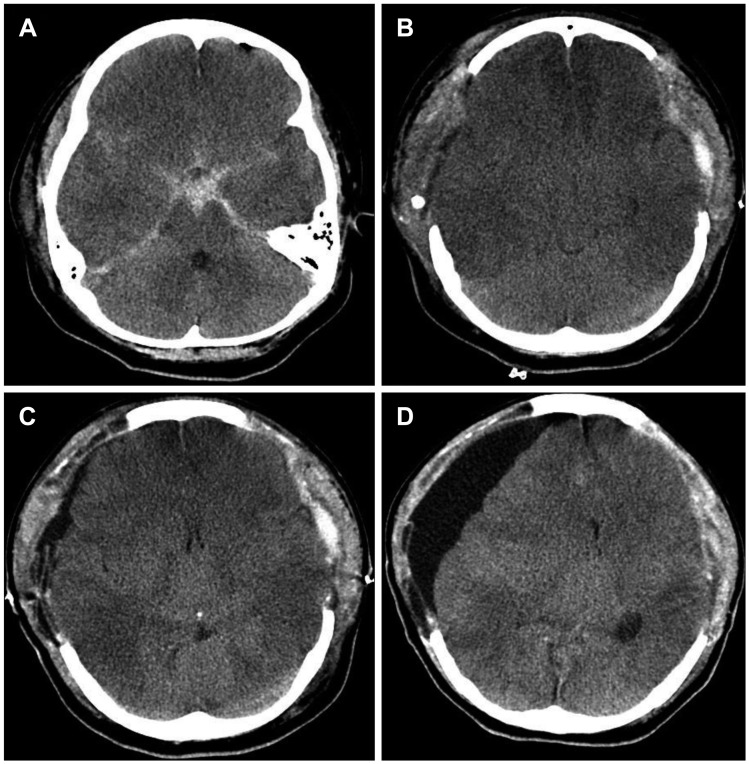Korean J Neurotrauma.
2018 Oct;14(2):93-98. 10.13004/kjnt.2018.14.2.93.
The Risk Factors of Subdural Hygroma after Decompressive Craniectomy
- Affiliations
-
- 1Department of Neurosurgery, Wonju Severance Christian Hospital, Yonsei University Wonju College of Medicine, Wonju, Korea. nschoi@yonsei.ac.kr
- KMID: 2424319
- DOI: http://doi.org/10.13004/kjnt.2018.14.2.93
Abstract
OBJECTIVE
Subdural effusion, also known as subdural hygroma (SDG), is a secondary complication that can occur after decompressive craniectomy (DC). However, the pathogenesis of SDG is not fully understood. It is unclear whether SDG occurrence is related to preoperative patient status or surgical technique. The purpose of this study is to identify risk factors for SDG after DC.
METHODS
Fifty-nine patients who underwent DC from January 2016 to December 2016 at the same institution were analyzed. We retrospectively reviewed the clinical and radiological features of the patients. We divided the patients into two groups based on the occurrence of SDG after DC. The risk factors for SDG were analyzed.
RESULTS
The overall SDG rate after DC was 39% (23 patients). A statistically significant association was observed between preoperative diagnosis, e.g., subdural hemorrhage (SDH; odds ratio [OR], 4.99; 95% confidence interval [CI], 1.36-18.34) or subarachnoid hemorrhage (SAH; OR, 4.18; 95% CI, 1.07-16.32), and the occurrence of SDG after DC. Traumatic brain injury (OR, 4.91; 95% CI, 1.35-17.91) and preoperative cortical opening (OR, 4.77; 95% CI, 1.39-16.32) were important risk factors for SDG. Several surgical techniques did not show a statistically significant association with SDG. The occurrence of SDG after DC was related to the length of hospital stay (p=0.012), but not to prognosis.
CONCLUSION
After DC, SDG is not related to patients' prognosis but to the length of hospital stay. Therefore, it is necessary to study the occurrence of postoperative SDG by confirming the presence of preoperative SDH, SAH, and cortical opening.
MeSH Terms
Figure
Cited by 1 articles
-
Prediction of Shunt-Dependent Hydrocephalus after Primary Supratentorial Intracerebral Hemorrhage with a Focus on the Influence of Craniectomies
Yong-sook Park, Joon Cho
J Korean Neurosurg Soc. 2022;65(4):582-590. doi: 10.3340/jkns.2021.0142.
Reference
-
1. Aarabi B, Chesler D, Maulucci C, Blacklock T, Alexander M. Dynamics of subdural hygroma following decompressive craniectomy: a comparative study. Neurosurg Focus. 2009; 26:E8.
Article2. Adamo MA, Deshaies EM. Emergency decompressive craniectomy for fulminating infectious encephalitis. J Neurosurg. 2008; 108:174–176. PMID: 18173329.
Article3. Da Costa DG, Adson AW. Subdural hygroma. Arch Surg. 1941; 43:559–567.4. Feng JF, Jiang JY, Bao YH, Liang YM, Pan YH. Traumatic subdural effusion evolves into chronic subdural hematoma: two stages of the same inflammatory reaction? Med Hypotheses. 2008; 70:1147–1149. PMID: 18248915.
Article5. Fisher CM, Ojemann RG. Bilateral decompressive craniectomy for worsening coma in acute subarachnoid hemorrhage. Observations in support of the procedure. Surg Neurol. 1994; 41:65–74. PMID: 8310390.
Article6. Haines DE, Harkey HL, al-Mefty O. The “subdural” space: a new look at an outdated concept. Neurosurgery. 1993; 32:111–120. PMID: 8421539.7. Han CY, Backous DD. Basic principles of cerebrospinal fluid metabolism and intracranial pressure homeostasis. Otolaryngol Clin North Am. 2005; 38:569–576. PMID: 16005717.
Article8. Hofmeijer J, Kappelle LJ, Algra A, Amelink GJ, van Gijn J, van der Worp HB. Surgical decompression for space-occupying cerebral infarction (the Hemicraniectomy After Middle Cerebral Artery infarction with Life-threatening Edema Trial [HAMLET]): a multicentre, open, randomised trial. Lancet Neurol. 2009; 8:326–333. PMID: 19269254.
Article9. Jamieson KG, Yelland JD. Surgically treated traumatic subdural hematomas. J Neurosurg. 1972; 37:137–149. PMID: 5046082.
Article10. Jeon SW, Choi JH, Jang TW, Moon SM, Hwang HS, Jeong JH. Risk factors associated with subdural hygroma after decompressive craniectomy in patients with traumatic brain injury: a comparative study. J Korean Neurosurg Soc. 2011; 49:355–358. PMID: 21887394.11. Koizumi H, Fukamachi A, Nukui H. Postoperative subdural fluid collections in neurosurgery. Surg Neurol. 1987; 27:147–153. PMID: 3810442.
Article12. Lee KS, Bae WK, Bae HG, Yun IG. The fate of traumatic subdural hygroma in serial computed tomographic scans. J Korean Med Sci. 2000; 15:560–568. PMID: 11068995.
Article13. Lee KS, Bae WK, Park YT, Yun IG. The pathogenesis and fate of traumatic subdural hygroma. Br J Neurosurg. 1994; 8:551–558. PMID: 7857535.
Article14. Liu Y, Gong J, Li F, Wang H, Zhu S, Wu C. Traumatic subdural hydroma: clinical characteristics and classification. Injury. 2009; 40:968–972. PMID: 19540485.
Article15. Ohno K, Suzuki R, Masaoka H, Matsushima Y, Inaba Y, Monma S. Chronic subdural haematoma preceded by persistent traumatic subdural fluid collection. J Neurol Neurosurg Psychiatry. 1987; 50:1694–1697. PMID: 3437306.
Article16. Rabe EF, Flynn RE, Dodge PR. A study of subdural effusions in an infant. With particular reference to the mechanisms of their persistence. Neurology. 1962; 12:79–92. PMID: 14489575.
Article17. Rabe EF, Flynn RE, Dodge PR. Subdural collections of fluid in infants and children. A study of 62 patients with special reference to factors influencing prognosis and the efficacy of various forms of therapy. Neurology. 1968; 18:559–570. PMID: 5691016.
Article18. Santana-Cabrera L, Pérez-Acosta G, Rodríguez-Escot C, Lorenzo-Torrent R, Sánchez-Palacios M. Complications of post-injury decompressive craniectomy. Int J Crit Illn Inj Sci. 2012; 2:186–188. PMID: 23181215.
Article19. Schachenmayr W, Friede RL. The origin of subdural neomembranes. I. Fine structure of the dura-arachnoid interface in man. Am J Pathol. 1978; 92:53–68. PMID: 686148.20. St John JN, Dila C. Traumatic subdural hygroma in adults. Neurosurgery. 1981; 9:621–626. PMID: 7322326.
Article21. Stone JL, Lang RG, Sugar O, Moody RA. Traumatic subdural hygroma. Neurosurgery. 1981; 8:542–550. PMID: 7266792.
Article22. Weir B. Oncotic pressure of subdural fluids. J Neurosurg. 1980; 53:512–515. PMID: 7420173.
Article23. Wetterling T, Demierre B, Rama B, Nekic M. Protein analysis of subdural hygroma fluid. Acta Neurochir (Wien). 1988; 91:79–82. PMID: 3394551.
Article24. Yang XF, Wen L, Li G, Zhan RY, Ma L, Liu WG. Contralateral subdural effusion secondary to decompressive craniectomy performed in patients with severe traumatic brain injury: incidence, clinical presentations, treatment and outcome. Med Princ Pract. 2009; 18:16–20. PMID: 19060485.
Article
- Full Text Links
- Actions
-
Cited
- CITED
-
- Close
- Share
- Similar articles
-
- The Risk Factors for Hydrocephalus and Subdural Hygroma after Decompressive Craniectomy in Head Injured Patients
- Paradoxical Herniation after Decompressive Craniectomy for Acute Subdural Hematoma
- Chronic Subdural Hematoma Superimposed on Posttraumatic Subdural Hygroma: A Report of Three Cases
- Risk Factors Associated with Subdural Hygroma after Decompressive Craniectomy in Patients with Traumatic Brain Injury : A Comparative Study
- Risk Factors for the Post-Traumatic Hydrocephalus Following Decompressive Craniectomy in Severe Traumatic Injury Patients



